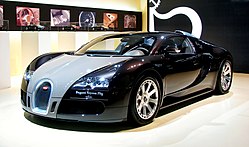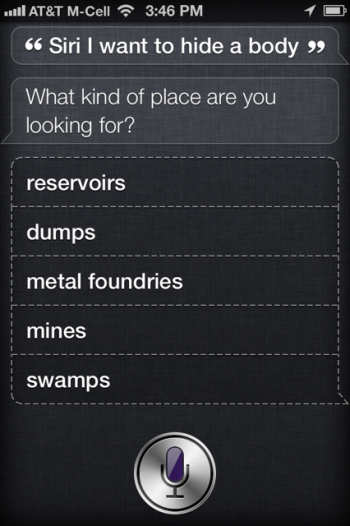Bugatti Veyron
 | |
| Manufacturer | Bugatti Automobiles and Volkswagen Group (parent company) |
|---|---|
| Production | 2005–2011 (last 16.4 sold) 2008-present (Grand Sport) 2010-present (Super Sport) |
| Assembly | Molsheim, Alsace, France |
| Predecessor | Bugatti EB110 |
| Class | Sports car |
| Body style | Standard: 2-door coupé Variant: targa top |
| Layout | Longitudinal mid-engine, permanent all-wheel drive |
| Engine | Standard: 8.0 L (488 cu in) W16 quad-turbocharged 1,001 PS (736 kW; 987 bhp)[1] Super Sport: 1,200 PS (883 kW; 1,184 bhp)[1][2] |
| Transmission | 7-speed DSG sequential |
| Wheelbase | 2,710 mm (106.7 in) |
| Length | 4,462 mm (175.7 in) |
| Width | 1,998 mm (78.7 in) |
| Height | 1,159 mm (45.6 in) |
| Kerb weight | 1,888 kg (4,162 lb) |
| Designer | Jozef Kaban[3] |
Designed and developed by Volkswagen Group (based on the Bentley Hunaudieres concept) and produced by Bugatti Automobiles SAS at their headquarters in Château Saint Jean in Molsheim (Alsace, France), the Veyron's chief designer was Hartmut Warkuss, and the exterior was designed by Jozef Kabaň of Volkswagen, with much of the engineering work being conducted under the guidance of former Peterbilt Trucks engineer and now Bugatti Engineering chief Wolfgang Schreiber. Though commissioned by Volkswagen, this car is only sold through the Bugatti manufacturers and cannot be found at any Volkswagen dealer.
A number of special variants have been produced, including two targa tops. In December 2010, Bugatti began offering prospective buyers the ability to customize exterior and interiors colours by using the Veyron 16.4 Configurator application on the marque's official website.[6][7]
Contents[hide] |
[edit] Name origin
The car is named after French racing driver Pierre Veyron, who won the 24 hours of Le Mans in 1939 while racing for the original Bugatti company. The 16.4 refers to 16 cylinders and 4 turbochargers.[8][edit] Specifications and performance
The Veyron features a 16 cylinder engine, equivalent to two narrow-angle V8 engines mated in a W configuration. Each cylinder has four valves for a total of sixty four, but the narrow staggered V8 configuration allows two overhead camshafts to drive two banks of cylinders so only four camshafts are needed. The engine is fed by four turbochargers and displaces 7,993 cubic centimetres (487.8 cu in), with a square 86 by 86 mm (3.4 by 3.4 in) bore and stroke.  | |
| Problems listening to these files? See media help. | |
The car's wheelbase is 2,710 mm (106.7 in). Overall length is 4,462 mm (175.7 in), width 1,998 mm (78.7 in) and height 1,204 mm (47.4 in). The Bugatti Veyron has a total of ten radiators:[11]
- 3 heat exchangers for the air-to-liquid intercoolers.
- 3 engine radiators.
- 1 for the air conditioning system.
- 1 transmission oil radiator.
- 1 differential oil radiator.
- 1 engine oil radiator.
[edit] Engine output
According to Volkswagen Group and certified by TÜV Süddeutschland, the final production Veyron engine produces 1,001 metric horsepower (736 kW; 987 bhp) of motive power, and generates 1,250 newton metres (922 ft·lbf) of torque.[1][14] The nominal figure has been stated by Bugatti officials to be conservative, with the real total being 1,020 metric horsepower (750 kW; 1,006 bhp) or more.[edit] Super Sport edition
The Veyron Super Sport features an engine power increase from the standard 1,001 metric horsepower (736 kW; 987 bhp) to 1,200 metric horsepower (883 kW; 1,184 bhp) and torque of 1,500 N·m (1,100 ft·lbf) and a revised aerodynamic package.[4] It was shown publicly for the first time at the Pebble Beach Concours d'Elegance in August 2010.[3]Bugatti's official test driver Pierre Henri Raphanel drove the Super Sport version of the Veyron on Volkswagen's Ehra-Lessien high-speed test track to establish the car's top speed. With representatives of the Guinness Book of Records and German Technical Inspection Agency (TÜV) on hand, Raphanel made passes around the big oval in both directions achieving an average maximum speed of 431.072 km/h (267.856 mph).[15] Once produced for sale, the first five Super Sports will sport the same black and orange finish as the first production car, which was used to set the speed record, and all production models will be electronically limited to 415 km/h (258 mph) to protect the tyres.[4]
[edit] Top speed
German inspection officials recorded an average top speed of the original version of 408.47 km/h (253.81 mph)[5] during test sessions on the Ehra-Lessien test track on 19 April 2005.This top speed was verified by James May on Top Gear in November 2006, again at Volkswagen Group's private Ehra-Lessien test track. May noted that at top speed the engine consumes 45,000 litres (9,900 imp gal) of air per minute (as much as a human breathes in four days). The Veyron has the highest top speed of any street legal production car. Once back in the Top Gear studio, James was asked by co-presenter Jeremy Clarkson what the Veyron felt like to drive at 407 km/h (253 mph), May replied that it was "totally undramatic", and very stable at speed. It only wobbled slightly as the air brake moved in the vertical position to slow the car down at lower speeds.[16]
On 4 July 2010, Bugatti's official test driver Pierre Henri Raphanel piloted the Super Sport edition and was clocked at an average of 431.072 km/h (267.856 mph) on the same track, taking back the title from the SSC Ultimate Aero TT as the fastest production vehicle of all time. The 431.072 km/h mark was reached by averaging the Super Sport's two test runs, the first reaching 427.93 km/h (265.90 mph) and the second 434.20 km/h (269.80 mph). The record run was certified by the German government and the Guinness Book of World Records.[17]
The car's everyday top speed is listed at 350 km/h (220 mph). When the car reaches 220 km/h (140 mph), hydraulics lower the car until it has a ground clearance of about 9 cm (3.5 in). At the same time, the wing and spoiler deploy. In this handling mode the wing provides 3,425 newtons (770 lbf) of downforce, holding the car to the road.[11]
For top speed mode the driver must, while at rest, toggle a special top speed key to the left of the driver's seat. A checklist then establishes whether the car and its driver are ready to attempt to reach 407 km/h (253 mph). If so, the rear spoiler retracts, the front air diffusers shut, and normal 12.5 cm (4.9 in) ground clearance drops to 6.5 cm (2.6 in).
[edit] Braking
The Veyron's brakes use cross drilled, radially vented carbon fibre reinforced silicon carbide (C/SiC) composite discs, manufactured by SGL Carbon, which have a much greater resistance to brake fade when compared with conventional cast iron discs. The lightweight aluminium alloy monobloc brake calipers are made by AP Racing; the fronts have eight[11] titanium pistons and the rear calipers have six pistons. Bugatti claims maximum deceleration of 1.3 g's on road tyres. As an added safety feature, in the event of brake failure, an anti-lock braking system (ABS) has also been installed on the handbrake.Prototypes have been subjected to repeated 1.0 g braking from 312 km/h (194 mph) to 80 km/h (50 mph) without fade. With the car's acceleration from 80 km/h (50 mph) to 312 km/h (194 mph), that test can be performed every 22 seconds. At speeds above 200 km/h (120 mph), the rear wing also acts as an airbrake, snapping to a 55° angle in 0.4 seconds once brakes are applied, providing an additional 0.68 g (6.66 m/s2) of deceleration (equivalent to the stopping power of an ordinary hatchback).[11] Bugatti claims the Veyron will brake from 400 km/h (250 mph) to a standstill in less than 10 seconds, though distance covered in this time will be half of a kilometer (third of a mile).[11]
[edit] Specifications and statistics
| Basic stats[1][2] | |||
|---|---|---|---|
| Layout and body style | Mid-engine, four-wheel drive, two-door coupé/targa top | Base price | €1,225,000 (GB£1,065,000/US$1,700,000) Super Sport: €1,912,500 (GB£1,665,000/US$2,700,000) |
| Internal combustion engine | 8.0 litre W16, 64v 2xDOHC quad-turbocharged petrol engine | Engine displacement and max. power | 7,993 cc (487.8 cu in) 1,001 metric horsepower (736 kW; 987 bhp) Super Sport: 1,200 metric horsepower (883 kW; 1,184 bhp) |
| Performance | |||
| Top speed | 408.47 km/h (253.81 mph) (average) Super Sport: 431.072 km/h (267.856 mph) (average) | ||
| 0–100 km/h (0–62.1 mph) | 2.46 seconds | 0–240 km/h (0–149.1 mph) | 9.8 seconds |
| 0–300 km/h (0–186.4 mph)[18] | 14.6 seconds | 0–400 km/h (0–248.5 mph)[19][20] | 50 seconds |
| Standing quarter-mile (402 m)[20] | 10.2 seconds at 230 km/h (142.9 mph) | ||
| Fuel economy[21] | |||
| EPA city driving | 8 miles per U.S. gallon (29 L/100 km; 9.6 mpg-imp) | EPA highway driving | 13 miles per U.S. gallon (18 L/100 km; 16 mpg-imp) |
| Top speed fuel economy | 3 miles per U.S. gallon (78 L/100 km; 3.6 mpg-imp), or 1.4 U.S. gal (5.3 L; 1.2 imp gal) per minute | ||
[edit] Sales
| Units sold | |
|---|---|
| 2005 | 5[22] |
| 2006 | 44[22] |
| 2007 | 81[23] |
| 2008 | 71[24] |
| 2009 | 50[24] |
| 2010 | 40[25] |
| 2011 | 91 |
| Total | 300 |
- ^ The last Veyron, No 300 was sold September 2011.
[edit] Special versions
- Pur Sang
|
- Fbg Par Hermès
|
- Sang Noir
|
- Bleu Centenaire
- Grand Sport
|
- Grand Sport Sang Bleu
|
- Grand Sport Grey Carbon
- Grand Sport L'Or Blanc
- Super Sport
The Super Sport was featured on Series 15, Episode 5 of Top Gear, where presenter, James May attempted to set the speed record. It managed 417 km/h (259 mph), briefly setting a new production car speed record. Later in the day though, one of Bugatti's test drivers (Pierre Henri Raphanel) broke May's previous record, claiming it through runs in both directions (May only did one run in one direction) and registering an average top speed of 431.072 km/h (267.856 mph). The car then went round the Top Gear Test Track and topped the lap leader board with a 1:16.8 time, beating the 1:17.1 record set previously by the Gumpert Apollo Sport.
- 16C Galibier Concept
Main article: Bugatti 16C Galibier Concept
The Bugatti 16C Galibier Concept is a prototype of a luxury sedan which was presented officially in September by Bugatti prior to the IAA 2009. A derivative of the concept vehicle is expected to reach the market in 2013. The car is a 4-door luxury sedan which shares the W16 8.0L engine of the Veyron, but with two superchargers instead of four turbochargers for improved torque.[edit] Criticisms and comments
Gordon Murray, designer of the McLaren F1 (which for many years was the fastest production car ever built) said the following about the Bugatti Veyron in UK auto magazine evo during its development period:Murray later brought up and criticized Volkswagen for "scamming" car buyers in the 1990s for buying the cheapest parts possible for the production of Jettas and Golfs, allowing Volkswagen to make a larger profit off their car sales, funding the construction of the Bugatti Veyron. However, Murray was impressed with the Veyron's engine and transmission after he test drove one for Road and Track magazine.[41]The most pointless exercise on the planet has got to be this four-wheel-drive, thousand-horsepower Bugatti—Gordon Murray[40]
[edit] Reviews
[edit] Top Gear
The Veyron has received considerable praise from all three presenters of the popular BBC motoring show Top Gear. While initially skeptical that it would ever be produced, Jeremy Clarkson later declared the Veyron "the greatest car ever made and the greatest car we will ever see in our lifetime." James May described the Veyron as "our Concorde moment." Clarkson test drove the Veyron from Alba, northern Italy to London in a race against James May and Richard Hammond who made the journey in a Cessna 182 aeroplane.A few episodes later, James May drove the Veyron at the VW test track and took it to its top speed of 407.16 km/h (253.00 mph). During the second episode of the 13th series, Richard Hammond raced the Veyron against the McLaren F1 driven by The Stig in a one mile (1.6 km) drag race in Abu Dhabi, commenting on Bugatti's "amazing technical achievement" versus the "non gizmo" racing purity of the F1. While the F1 was quicker off the line and remained ahead until both cars were travelling at approximately 200 km/h, the Bugatti overtook its competitor from 200 to 300 km/h, and emerged the victor. Hammond has stated that he did not use the Veyron's launch control in order to make the race more interesting.
The Veyron also won the award for Car of the Decade in Top Gear's end of 2010 award show. Clarkson commented "It was a car that just rewrote the rule book really, an amazing piece of engineering, a genuine Concorde moment". When the standard version was tested, it did not reach the top of the lap time leader board, which was speculated as being due to the car's considerable weight disadvantage against the other cars towards the top. The SuperSport version, however, achieved the fastest ever time of 1:16.8 (later beaten by the Ariel Atom V8, the McLaren MP4-12C and the Lamborghini Aventador[42]), as well as being taken to a (verified) average top speed of 431.072 km/h (267.856 mph) by Raphanel on the programme,[43] thenceforth retaking its position as the fastest production car in the world.[44][45][46]
In 2011, Bugatti Veyron: A Quest for Perfection - The Story of the Greatest Car in the World[47] was published which took the stance that the car had now become so famous that it was effectively a bona fide 'celebrity'. The book follows its author Martin Roach as he attempts to track down and drive the car, along the way interviewing chief designers, test drivers, and the president of Bugatti.















 We’ve all had some past experience with the use of voice-controlled technology. Many a parody commercial has been made pointing out the oft-comical flaws in the voice-command technology of generations past. But with the power of the dual-core A5 chip in the latest iPhone 4S, Siri is bringing voice assistance into the new millennium, and very well may be the biggest innovation in mobile technology since the smartphone itself.
We’ve all had some past experience with the use of voice-controlled technology. Many a parody commercial has been made pointing out the oft-comical flaws in the voice-command technology of generations past. But with the power of the dual-core A5 chip in the latest iPhone 4S, Siri is bringing voice assistance into the new millennium, and very well may be the biggest innovation in mobile technology since the smartphone itself.
